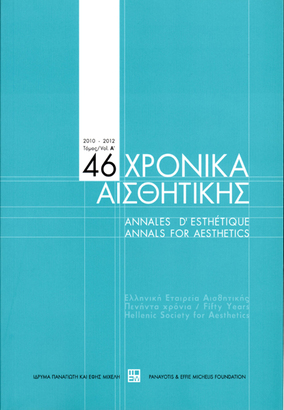Η αισθητική στον εικοστό αιώνα και οι θέσεις του Adorno
Part of : Χρονικά αισθητικής : ετήσιον δελτίον της Ελληνικής Εταιρείας Αισθητικής ; Vol.46, No.Α, 2010, pages 211-217
Issue:
Pages:
211-217
Parallel Title:
Aesthetics in the twentieth century and the views of Adorno
Section Title:
Αισθητική - Φιλοσοφία της Τέχνης - Ιστορία της Τέχνης Aesthetics/Philosophy of Art - History of Art
Author:
Abstract:
The dominant historical phenomena in Europe during the nineteenth century, mainly the industrial and the scientific revolution, had social effects on the various art forms, as well as on the disruption of a single style that had prevailed from the time of Da Vinci and Shakespeare (16th-17th century) to about the time of Goethe. The philosophy of art, that is eighteenth- and nineteenth-century aesthetics, gave way to modern aesthetics, which was separated from philosophy, of which it had been a branch in its own right.Theodor Gustav Fechner (1801-1887) characterized the old aesthetics as aesthetics “from above”, implying the deductive method (from the general to the partial) in the analyses, in contrast to the modern aesthetics, which he characterized as aesthetics “from below”, implying the inductive method (from the partial to the general), also in the analyses. Intermediately, the method of T.W. Adorno (1903-1969) does not function exclusively “from below”, but emerges also from the old method “from above”, as reaction to the brutality of industrialized and commercialized culture. This is Adorno’s dialectical method of thinking, through which the idealism of Hegel is also justified.Adorno approaches art through the dialectical method of his aesthetics, which consists of three components: the purely musicological, the idealistic-philosophical (Hegel), and the social-philosophical (Marx). He characterizes the work of art as autonomous, but concurrently also as a social fact (fait sodai). The language the philosopher uses in order to describe even the simple concepts of current reality is an artistic language of incredible wealth in creating representations and negotiating the truth.Twentieth-century aesthetics follows three different directions: in the East the sociologically orientated Marxist approach held sway, while in the West the Neo-Marxist, distinguished figures in which were Georg Lukâcs, Ernst Bloch, Walter Benjamin, as well as the representatives of the Critical Theory of the Frankfurt School, Herbert Marcuse and Theodor Wiesengrund Adorno. The last could be described as the champion of idealism in opposition to the reality of artistic militancy. He never sacrificed the autonomy of the aesthetic object to socio-political aims. The multifaceted philosopher and sociologist sided for the hermetic and against the militant work of art. The concept of artistic autonomy is one of the fundamental concepts of his theory of aesthetics.
Subject:
Subject (LC):




